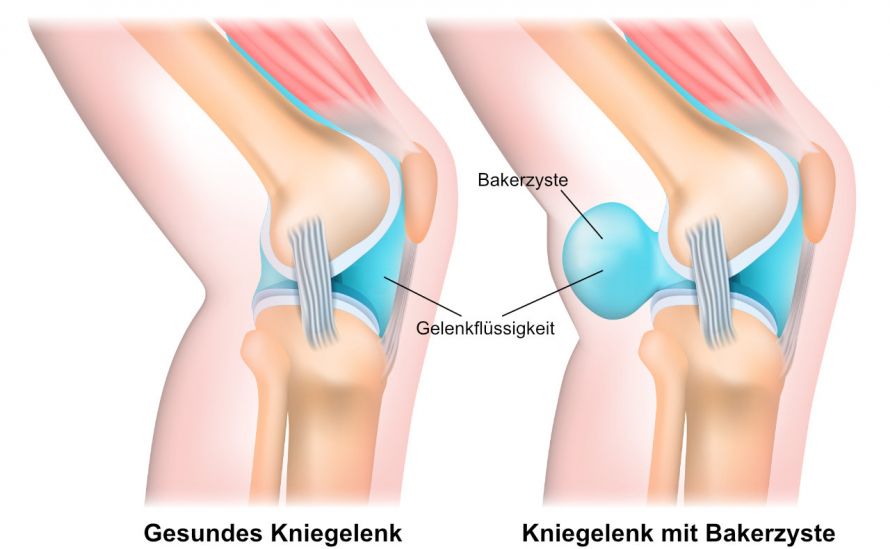Here you can find additional information and selected specialists and centers for the treatment of Baker's cysts.
Here you can find additional information and selected specialists and centers for the treatment of Baker's cysts.
Recommended specialists
Brief overview:
- What is a Baker cyst? An accumulation of synovial fluid in the hollow of the knee.
- Symptoms: A sensation of tightness behind the knee and disruptions of venous drainage, which can resemble deep vein thrombosis in the lower leg. The clinical picture may worsen with simultaneous rheumatoid arthritis.
- Diagnosis: The disease can be easily identified with an ultrasound scan and an MRI. For optimal treatment, the diagnosis must accurately clarify the cause.
- Treatment: For therapy, the underlying disease must be treated. Surgery is only rarely necessary.
Article overview
Definition and causes of Baker's cysts
A cyst is a cavity filled with synovial fluid. The accumulation of synovial fluid in the hollow of the knee from the knee joint is called a Baker's cyst. This accumulation of fluid creates a bump in the back of the knee. Baker's cysts used to also be called popliteal cysts (popliteal = affecting the hollow at the back of the knee).
The cause of Baker's cyst development is usually inflammation or more severe irritation of the knee joint. As a result, the body produces more synovial fluid, which is deposited under the skin in the hollow of the knee.
The fluid cannot drain away because the muscles around the joint compress the tissue. This creates a natural valve: More and more fluid accumulates in the Baker's cyst, while drainage is not possible.
Symptoms of a Baker's cyst
Baker's cysts produce a feeling of tightness in the back of the knee, especially when extending the joint. Due to the accumulation of fluid, affected persons often can no longer fully bend the knee. Pain may also occur.
If the cyst is severely swollen, it can affect the nerves and press on blood vessels. If the veins are compressed, blood flow disorders may occur in them. They resemble those of a deep vein thrombosis in the lower leg.
Under certain circumstances, the cyst may rupture. Severe pain may occur during this process. As a result, inflammation often appears in the knee and lower leg. This manifests in redness and swelling.
Diagnosing a Baker's cyst
Larger Baker's cysts are usually easy to palpate in the back of the knee.
Imaging techniques produce clear images of a Baker's cyst. Often this involves an ultrasound scan; sometimes magnetic resonance imaging (MRI) is also used.
Diagnosis of a Baker's cyst also includes identifying the underlying condition, such as
- Meniscus damage,
- Knee osteoarthritis,
- Ligament instability, or
- A rheumatic disease.
The underlying condition causing a Baker's cyst must also be identified.

Left, a healthy knee joint; right, a knee joint with a Baker's cyst in the popliteal fossa © designua | AdobeStock
Treating Baker's cysts
The treatment for Baker's cysts depends on its extent. Small Baker’s cysts can be treated with medication. For larger fluid accumulations, the cyst can be punctured and the fluid drained.
However, to prevent another Baker's cyst from developing, the underlying condition must be treated.
Surgical removal of a Baker's cyst is justified only in exceptional cases.
Specialists for Baker’s cysts: education and training
Orthopedists provide care for all musculoskeletal disorders, including Baker's cysts.
After finishing their medical studies, an orthopedic surgeon must also complete further training to become a specialist in orthopedics and trauma surgery. This training period in trauma surgery/orthopedics typically lasts 72 months.
Find experienced doctors specializing in the diagnosis and treatment of Baker's cysts here on the Leading Medicine Guide!







































